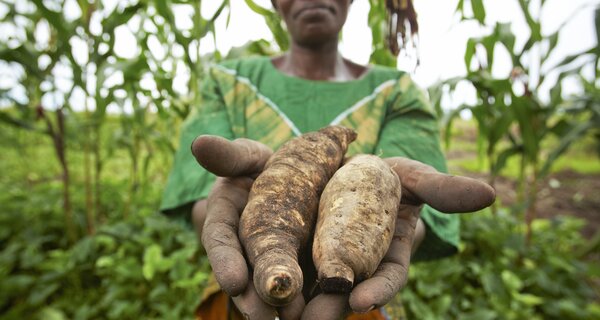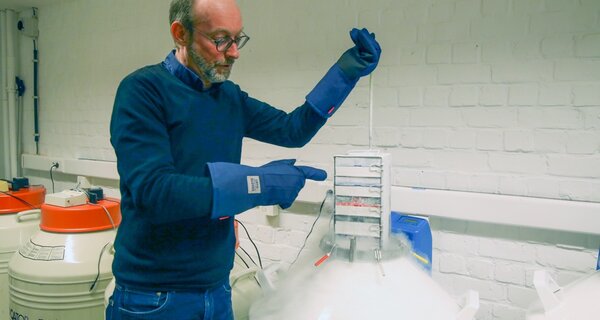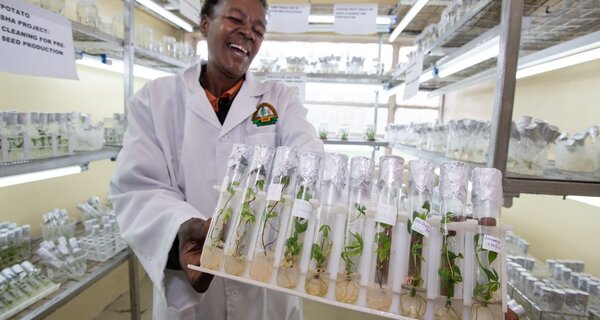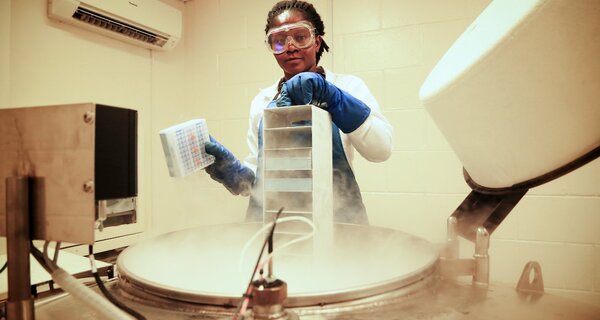Chill Solution for Meeting Future Demand of Sweetpotato
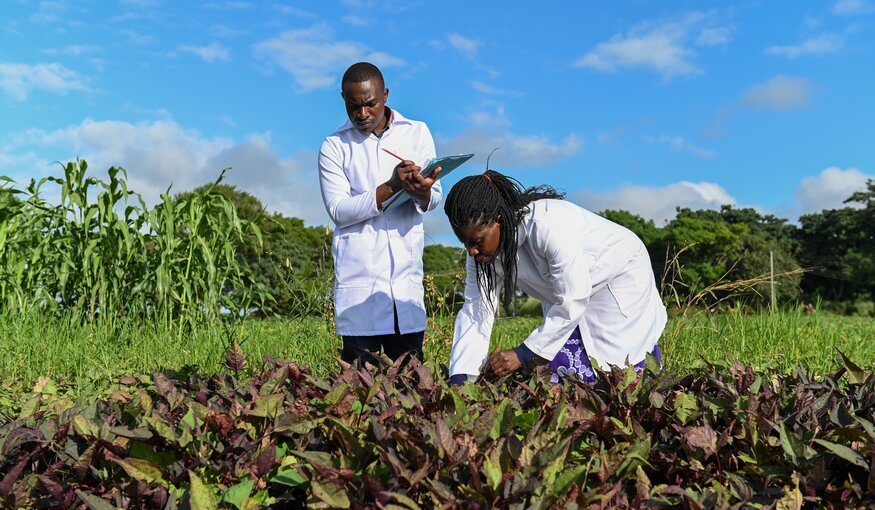
Staff at the National Plant Genetic Resources Centre (NPGRC) of the Zambia Agriculture Research Institute (ZARI) check sweet potato growing in the NPGRC field genebank at ZARI’s Mt Makulu Central Research Station, Lusaka. (Photo: Neil Palmer/Crop Trust)
31 March 2023
From Lima to Lusaka, open the menu of one of the fancier burger joints and you may well find fries made from sweetpotatoes rather than the more common, blander sort of tuber. The value chain that ensures that this delicious snack stays on the menu — no matter what — obviously includes farmers labouring in their fields, but it doesn’t start there. It starts in genebanks. And, alas, in neither place is the sweetpotato entirely safe from harm.
That is why partners of the project Sweetpotato, a model for food security and long-term conservation of biodiversity joined forces to test a model rooted in cryopreservation that could work not only for sweetpotato, but also for other crops that cannot be conserved as seeds, such as that other potato, cassava (which incidentally also makes nice chips, but that’s another story…) and garlic.
The Main Show
Mildly sweet and satisfyingly starchy, sweetpotatoes are enjoyed around the globe.
And in many places they are not an unusual side dish, but rather the main show.
In Zambia, for example, sweetpotato ranks first among root and tuber crops and sixth among all food crops in terms of the total area planted. It’s a staple in rural areas, but local foodies also enjoy it in a variety of dishes, even desserts and cream soups. And that’s a good thing, as the roots are highly nutritious, offering a whole array of vitamins and minerals that not only regular potatoes lack, but many other crops, too.
In Madagascar, especially in the south of the island state, sweetpotato is perfectly suited to the dry climate and the sandy soils. Malagasy agricultural experts are seeing changes in its consumption: people are increasingly keen to eat the root even when rice — the go-to national staple food — is an accessible option.
To keep up with the demand, farmers need to keep production high and sustainable, without relying too much on inputs such as fertilizers and pesticides. That means using the best varieties available.
But everyone has a different opinion on what is, indeed, the best. Best in terms of taste? Texture? Or maybe resistance to one of its greatest enemies, the weevil?
Enter sweetpotato diversity: different varieties of the root have different traits, including flavor, color, texture, size, nutritional content and other attributes.
To be able to capitalize on the different sweetpotato varieties, we need to keep them all safely somewhere. And here lies the challenge that brought together scientists from the Crop Trust, the International Potato Center (CIP), Zambia Agricultural Research Institute (ZARI), and FIFAMANOR (a center for rural development and applied research in Madagascar) with the generous support of the UK Government’s Darwin Initiative.
Chilled Sweetpotatoes
Compared to rice and maize, sweetpotato conservation is a more complicated and expensive process. Different varieties can be conserved as fully-grown plants in field collections or in vitro, meaning plantlets in test tubes under controlled conditions in the lab. But both of these options are pricey, labor-intensive and risky. A decade ago, due to disease and the lack of a functioning irrigation system, the National Plant Genetic Resources Centre, the national genebank of Zambia, lost its whole sweetpotato field collection.
The alternative that the partners of the Darwin Initiative-funded project Sweetpotato, a model for food security and long-term conservation of biodiversity are investigating is rather chilling.
To ensure the crop’s long-term conservation, vegetative parts of each variety need to be cryopreserved – that is stored in special tanks which are cooled by liquid nitrogen to -196°C. Think of Sylvester Stallone and Wesley Snipes floating in their cryo-prison in the 1990s hit movie, Demolition Man. (Or maybe better not. It wasn’t a great movie.)
But cryopreservation certainly is great, especially its long-term cost. Once a sample is prepared for cryopreservation, it costs a genebank only about US$2 a year to maintain it. Safeguarding that same sample in vitro costs up to US$60 a year.
A Model To Rule Them All
The Crop Trust, together with experts from Zambia, Madagascar and CIP, have been testing a model for long-term conservation of sweetpotato involving cryopreservation that they call ‘Clean & Share’.
“Our goal is to future-proof the sweetpotato and make sure that disease-free plants are always available to farmers,” said Sarada Krishnan, Director of Programs at the Crop Trust.
A quick scrub under running water won’t do the trick. Under the ‘Clean & Share’ model, project partners are collecting unique sweetpotato landraces, subjecting them to a special treatment to get rid of any viruses they may have, and processing them for cryopreservation. They are also returning disease-free planting material to smallholder farmers.
“The project brings relief to farmers and researchers because one of the biggest problems that farmers are having is low yields due to viral diseases, which are transmitted by planting material,” added Graybill Munkombwe, Principal Agriculture Research Officer, National Plant Genetic Resources Centre, ZARI. “Clean – that is, disease-free – planting material from this project will enhance farmers’ yields as less harvest will be lost.”
And the farmers of the future will be happy, too. Through the use of cryopreservation, partners of the sweetpotato project are keeping the root safe for them and their fry-loving customers.
“The project supports the long-term, secure back-up of crop collections which cannot be backed-up in the Svalbard Global Seed Vault,” explains David Ellis, former CIP genebank manager, highlighting its link to the Global Plant Cryopreservation Initiative. Adding missing diversity from Madagascar and Zambia to the global collection of sweetpotato held at CIP’s headquarters in Peru will ensure that the unique traits of these landraces will be available and accessible to plant breeders and other researchers worldwide and can be used to breed climate-resilient and pest- and disease-resistant varieties.
Your burger of the future may be printed in front of you, but the fries that go with it will still be the real thing, thanks to cryo.
Categories: The Sweetpotato Project, Sweetpotato, Food Security


